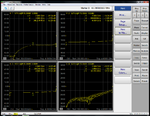Nia11
Newbie level 5
- Joined
- Jun 14, 2016
- Messages
- 10
- Helped
- 0
- Reputation
- 0
- Reaction score
- 0
- Trophy points
- 1
- Location
- Paris,France
- Activity points
- 87

Hello,
I am using keysight M9370A VNA, I just want to clear my doubts on VNA plots, I have attached the picture of VNA S parameters plots of an attenuator of 16dB ( connected to the ports of the VNA) with this post.
From the picture, It is clearly seen that the plots are in logmag format.
S11 plot - for example, at 2 GHz, it is -22.14 dB. So we can take Return loss, RL (at input)=-22.14 dB ( RL should be +VE, so we can take RL = 22.14dB ).
S21 plot - The value @ 2GHz is -14.24 dB, so we can take Insertion loss, IL = -14.24dB @ 2GHz. And Gain = - Insertion Loss. Therefore, Gain= 14.24 dB.
So my question is that the above measurements are correct or wrong?, because in the case of VNA S parameter measurements ,each article says different opinion. It was just confusing.
Is the VNA Logmag format shows just the value of S11 or S21(in the picture), and we have to calculate the Return loss and Insertion loss with the formulas below.?
RL = -20logǀS11ǀ dB
IL= -20logǀS21ǀ dB
So substituting the values of S11 and S21 we obtained from the picture, S11= -22.14dB and S21=-14.24dB
We get, RL = -26.9 dB = 26.9 dB.
IL= -23 dB and therefore Gain = 23 dB.
From the above two methods which one is correct, Could anyone please help me to clear this confusion. Thank you in advance.